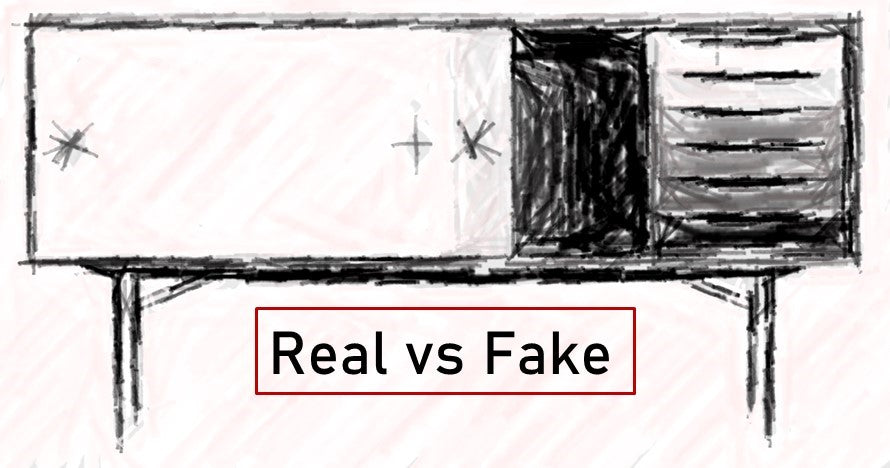
How to Identify Genuine Mid Century Modern Furniture (Real vs. Fake)
Identifying genuine mid-century modern (MCM) furniture involves a multifaceted approach that takes into account design characteristics, materials, construction techniques, makers' marks, and provenance. Here's a comprehensive guide on how to discern authentic mid-century pieces from reproductions or other styles.
- Design Characteristics: Mid-century modern furniture is notable for its simplicity, clean lines, and organic shapes. It often combines traditional materials like wood with non-traditional ones like metal, glass, vinyl, and plywood. Look for:
- Minimal ornamentation and sleek, streamlined designs.
- Functional forms that prioritize usability and comfort.
- Organic curves and geometric shapes.
- A mix of contrasting materials and textures.
- Tapered legs, often angled outward from the body of the piece.
- Materials and Construction: Genuine MCM furniture typically uses high-quality materials and shows a high standard of craftsmanship.
- Wood: Teak, walnut, oak, and rosewood are commonly used. Look for solid wood construction, although quality veneers over solid cores were also common.
- Metal: Brass, stainless steel, and chrome feature in hardware and accents. Joints should be seamless and welds clean.
- Finishes: Look for original patina on wood and metal, which can indicate age. Be cautious of pieces that have been refinished, as this can affect value.
- Construction: Dovetail joints, mortise and tenon, and other strong joinery methods are signs of quality craftsmanship.
- Upholstery: Original fabric may be worn but should feel of good quality. Reupholstery with period-appropriate materials can maintain value.
- Makers' Marks and Labels: Authentic pieces often have markings from the manufacturer or designer, such as stamps, labels, or embossed signatures.
- Familiarize yourself with marks from prominent MCM designers and manufacturers like Herman Miller, Eames, Knoll, Heywood-Wakefield, George Nelson, and Danish makers like Hans Wegner and Arne Jacobsen.
- Look for serial numbers, production dates, and other identifying information.
- Be aware that labels and marks can be reproduced, so they should not be the only factor in authenticating a piece.
- Provenance: Documented history of a piece can greatly assist in authenticating it.
- Provenance can include original purchase receipts, auction records, or documented history of previous ownership.
- Anecdotal history should be verified with physical evidence when possible.
- Research and Expertise: Becoming knowledgeable about MCM furniture is key.
- Read books, visit museums, and study authentic pieces in person.
- Familiarize yourself with the work and marks of well-known designers.
- Use online resources, forums, and communities to learn and ask questions.
- Condition: While age-appropriate wear can authenticate a piece, condition is also a factor.
- Check for signs of age, such as wear on handles, edges, and legs where use would be consistent.
- Unusual wear patterns or new-looking components may indicate a reproduction or restored piece.
- Comparisons: Compare potential purchases with known authentic pieces.
- Note proportions, as reproductions often get these wrong.
- Look at the fine details like the fit of drawers and the smoothness of mechanisms.
- Price and Seller: The price and reputation of the seller can also be indicators of authenticity.
- Price: Genuine mid-century modern furniture can command high prices due to its collectability and quality. Be wary of pieces that are significantly underpriced, as this could indicate a reproduction or a piece in poor condition.
- Seller: Purchase from reputable dealers who specialize in mid-century furniture or have a good track record. They should have knowledge about the pieces they sell and be able to provide information on authenticity.
- Consulting Experts: If you're still unsure about a piece's authenticity, consult an expert.
- Appraisers: Professional appraisers can provide evaluations based on their expertise and access to historical sales data.
- Auction Houses: Staff at reputable auction houses can often provide insights into a piece's authenticity and value.
- Investigate the Piece Itself: Examine the piece thoroughly, inside and out, top to bottom.
- Construction: Look for signs of handcrafted work, like irregularities in the wood grain or slight asymmetries in construction, which can be indicative of period pieces made before industrial manufacturing became the norm.
- Fasteners: Screws and other hardware can provide clues to age. Slotted screws are often older than Phillips head screws, and the presence of modern hardware is a telltale sign of a reproduction.
- Wear and Tear: Genuine wear should be appropriate for the piece's age. Check high-contact areas like chair arms, table edges, and drawer pulls for signs of use. Look under the piece for less obvious wear.
- Alterations: Be cautious of pieces that have undergone significant alterations, as these can diminish value and make authenticity harder to determine.
- Understanding Period Variations: Mid-century modern is a term that encompasses a wide period, roughly from the mid-1940s to the late 1960s.
- Early Mid-Century: Earlier designs might lean towards the Art Deco movement or the Modernist movement of the pre-war era.
- Mid-Century: True mid-century pieces, from the 1950s to the early 1960s, will have the iconic styles most associated with MCM.
- Late Mid-Century: Later pieces, from the late 1960s, might start blending into what is often referred to as post-modern or brutalist design.
- Books and Catalogs: Manufacturers' catalogs, historical design books, and old advertisements can provide valuable reference points for identifying furniture styles and periods.
- Online Resources: There are numerous online databases and forums where collectors and experts discuss mid-century furniture, and these can be valuable resources for learning and verification.
By combining these strategies, you can become more adept at identifying genuine mid-century modern furniture. Remember that while reproductions can be high in quality and aesthetic appeal, the true value in authentic MCM pieces lies in their historical significance, craftsmanship, and design. Whether you're a collector, a design enthusiast, or someone looking to furnish your home with timeless pieces, understanding these intricacies will help you make informed decisions and appreciate the beauty and heritage of mid-century modern furniture.
Comments
Leave a comment